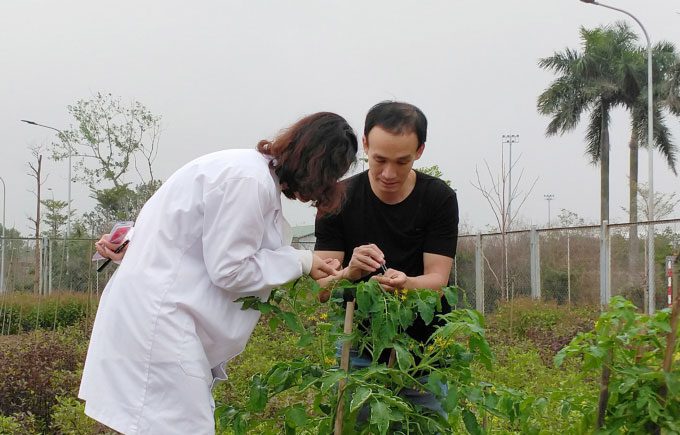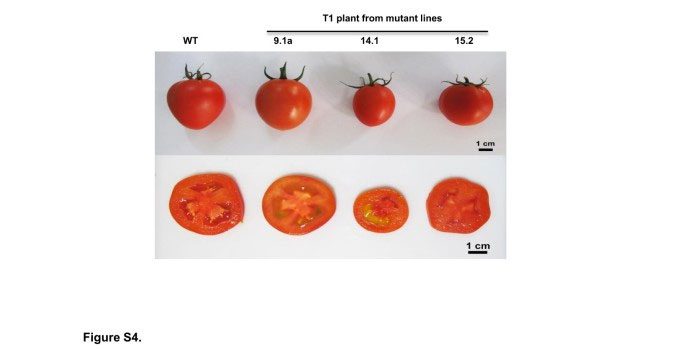Scientists have successfully created a gene-edited tomato using CRISPR/Cas9 technology, which has doubled the levels of sugar and amino acids.
The CRISPR/Cas9 gene editing system has been successfully applied by researchers at the Institute of Biotechnology (IBT), Vietnam Academy of Science and Technology, to a local tomato variety. The gene-edited tomato lines have shown an increase of 13-45% in sugar content and 62-132% in amino acid content compared to the non-edited control plants. These components contribute to the delicious flavor of tomatoes and enhance their nutritional value.
Dr. Do Tien Phat, the head of the research team, stated that most tomato varieties in the market are selected for consumption and industrial processing, focusing on traits such as rapid growth, large fruit size, and high yield, with little emphasis on flavor. Therefore, since 2019, the team has aimed to create mutant tomato lines to enhance flavor and nutritional value.
The team developed the CRISPR/Cas9 gene editing system carrying two gRNA targeting sequences to create targeted mutations in the upstream open reading frame (uORF) regions of the gene. This gene is involved in the synthesis of sugars and amino acids in tomato plants. Dr. Phat remarked that this technology can accurately edit specific gene sequences to produce desired traits in crops. This method is considered much quicker and more effective than traditional breeding methods.

Research team members assessing the morphological characteristics of the gene-edited tomato plant. (Photo: Research Team).
Using this system, the team successfully created targeted mutations in a pure tomato variety that was quite popular in Vietnam before. Experiments conducted in controlled greenhouse and experimental garden settings showed that the mutant tomato lines grew twice as much as the non-mutant control plants.
Unlike genetically modified organisms (GMOs), the tomato lines created using CRISPR/Cas9 technology have stable hereditary capabilities in subsequent generations and may not carry any foreign DNA sequences in their genomes. Scientists also noted that compared to the original (non-gene-edited) plants, the mutant tomato lines SlbZIP1-uORF exhibit desired traits (increased sugar and amino acid content) without showing any negative effects on phenotype or the growth and development of the plants.
According to Dr. Phat, the research results demonstrate the potential of this technology in improving the quality of tomatoes specifically and expanding its application to other crops. The mutant tomato lines created will serve as raw materials for breeding and selecting tomato varieties in the future. This technology can definitely help consolidate other desired traits in high-yield tomato varieties in Vietnam.
“This success opens up opportunities for breeders to improve desired traits in currently produced tomato plants or varieties of interest in the future,” he said.

Control tomato line (WT) compared to gene-edited tomato lines (T1). (Photo: Research Team).
The study was published in Planta by Springer Nature, a prestigious journal on plant biotechnology in the Q1 ISI group, in mid-February. Prior to this, the team had also successfully applied CRISPR/Cas9 technology to induce targeted mutations in the eIF4E gene in papaya to enhance resistance to the ring spot virus. This technology has also been successfully applied to various crops such as tobacco, beans, cucumbers, and rice.
Dr. Phat hopes to collaborate with domestic scientists to develop and apply this technology in crop improvement while also expanding research applications in animals and microorganisms.
He further noted that the first commercially available gene-edited plant in the world is the GABA tomato from Japan, which helps reduce stress and lower blood pressure.
Professor Dr. Chu Hoang Ha, Vice President of the Vietnam Academy of Science and Technology, stated that this is a practical application of gene editing technology to create changes for crops. Dr. Phat’s research, along with his colleagues, shows that Vietnamese scientists have quickly mastered CRISPR/Cas technology, developing methods to evaluate edited gene structures. “Mastering this technique opens up significant potential and opportunities for research on gene function in crops, towards being ready for studies to create lines/varieties for production purposes,” Professor Ha assessed.
He added that gene editing technology has many applications, especially in plants. This technology allows for targeted mutations, which can then be selected to eliminate foreign genes, helping crops exhibit characteristics similar to those of naturally mutated or traditionally bred plants. Due to its high applicability, many laboratories and biotechnology companies are utilizing this technique for the future of crop breeding.
Recognizing the promising prospects in this field, Professor Ha believes that expanding research requires testing and evaluation; thus, it needs targeted investment and the development of strong research groups. Additionally, guidelines should be issued for the registration of plant varieties; those created using new technologies should be directed into the evaluation process.





















































